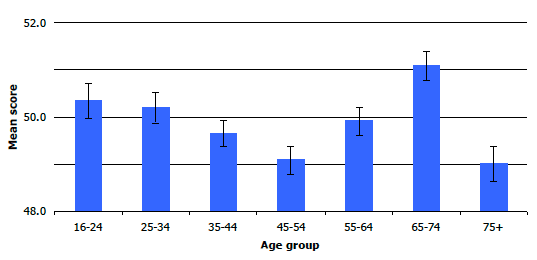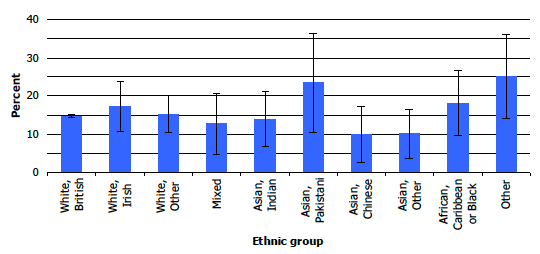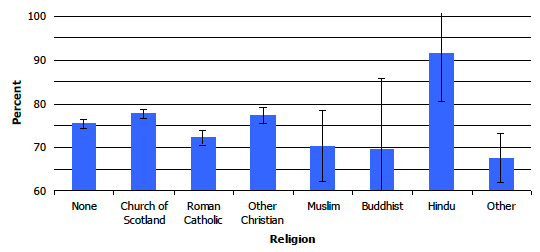Scottish Health Survey - topic report: equality groups
Topic report in the Scottish Health Survey series providing breakdowns of key health behaviours and outcomes by gender, age, ethnic group, religion, disability and sexual orientation.
This document is part of a collection
2 General health and mental wellbeing
Summary
- Men had a more positive view of their general health and reported higher mental wellbeing than women.
- Levels of mental wellbeing dip during the middle years and among the oldest age groups.
- Chinese people had the highest levels of self-assessed health.
- Hindus had the highest levels of self-assessed health and were the least likely to have a high GHQ-12 score.
- There was a strong association between disability, poor self-assessed health and low mental wellbeing.
- People who self-reported as bisexual reported poorer self-assessed health and lower mental wellbeing while the self-assessed health and mental wellbeing of gay men and lesbians was not significantly different from the average.
2.1 Measures of general health and mental wellbeing
This chapter considers general health and mental wellbeing by three indicators: self-assessed health, the Warwick-Edinburgh Mental Wellbeing Scale (WEMWBS) and the General Health Questionnaire (GHQ12).
Self-assessed health is a useful measure of how individuals regard their own overall health status. It is strongly related to the presence of chronic and acute disease, as well as being a good predictor of hospital admissions and mortality.1 All survey participants were asked to rate their health in general as 'very good', 'good', 'fair, 'bad' or 'very bad'. This question is used to monitor the National Indicator "improve self-assessed health".2
Mental wellbeing was measured using the Warwick-Edinburgh Mental Wellbeing Scale (WEMWBS). It has 14 items designed to assess: positive affect (optimism, cheerfulness, relaxation) and satisfying interpersonal relationships and positive functioning (energy, clear thinking, self-acceptance, personal development, mastery and autonomy).3 The scale uses positively worded statements with a five-item scale ranging from '1 - None of the time' to '5 - All of the time'. The lowest score possible is therefore 14 and the highest score possible is 70. The analysis presented in this report focuses on mean scores. WEMWBS is not designed to identify individuals with exceptionally high or low levels of positive mental health, so cut off points have not been developed4. This question is used to monitor the National Indicator "improve mental wellbeing".5
GHQ126 is a widely used standard measure of mental distress and psychological ill-health. It consists of 12 questions on concentration abilities, sleeping patterns, self-esteem, stress, despair, depression and confidence in the previous few weeks. Responses are scored with one point given for each time a particular feeling or type of behaviour was reported to have been experienced 'more than usual' or 'much more than usual' over the past few weeks. Scores are combined to create an overall score of between zero and twelve. A score of four or more (referred to as a 'high' GHQ12 score) has been used here to indicate the presence of a possible psychiatric disorder. GHQ12 measures deviations from people's usual functioning in the previous few weeks. It cannot, therefore, be used to detect chronic conditions. Research has shown GHQ12 scores to be associated with increased risk of mortality from several major causes in a dose-response pattern, even when controlling for health-related behaviours.7
It is well-known that general health and mental wellbeing are strongly associated with SIMD and household income and this is discussed in the main report.8
2.2 General health and mental wellbeing by gender
Men were significantly more likely than women to assess their health as being good or very good (77% compared with 75%). However, these may be partly be due to gender-specific assessments rather than objective differences.9 Men also had higher levels of positive wellbeing (score of 50.1 versus 49.7 on the WEMWBS scale). A higher proportion of women (17%) than men (12%) had a high GHQ-12 score.
2.3 General health and mental wellbeing by age
Self-assessed health was associated with age, with older groups significantly less likely to report being in good or very good health than younger age groups. 89% of 16-24 year olds reported being in good or very good health and this fell consistently with increasing age to reach a level of 53% for those aged 75 and over.
There was a complex association between mental wellbeing and age. People aged 16-24 (50.3) and 65-74 (51.1) had the highest levels of positive wellbeing and those aged 45-54 (49.1) and 75 and over (49.0) had the lowest. The relationship between GHQ12 and age showed an inverse pattern to that observed for WEMWBS. 45-54 year olds were most likely to have high GHQ scores (18%) whilst 65-74 year olds were least likely (10%). These patterns fit with the widely cited 'U-curve' in subjective wellbeing, where levels of self-reported subjective wellbeing dip during the middle years and among the oldest in society.10
Figure 2A: WEMWBS mean score, by age, 2008-2011 combined

2.4 General health and mental wellbeing by ethnic group
Those who reported their ethnic group as Pakistani were least likely to rate their health as good or very good (66%) although due to small sample sizes this was not significantly different from the national average of 76%. However, although it is not statistically significant, this does corroborate with other research which found that Pakistanis in Britain are less likely to report good health.11 Chinese respondents were the most likely to rate their health as good or very good (91%) and this was significantly different from the national average.
White British respondents had the lowest levels of wellbeing of all ethnic groups (mean WEMWBS score of 49.8). This was significantly lower than that the scores of White Other (51.2), African, Caribbean or Black (53.7) and Asian Other (53.5) ethnic groups.
Other ethnic groups (25%), Pakistani (23%) and African, Caribbean or Black groups (18%) had the highest proportion of respondents with high GHQ12 scores but none of these was significantly different from the Scottish average (15%). Chinese and Other Asian ethnic groups had the lowest proportion of high GHQ12 scores (both 10%) but again, these weren't significantly different from the national average.
Figure 2B: Prevalence of high GHQ-12 scores, by ethnic group, 2008-2011 combined

2.5 General health and mental wellbeing by religion
Hindus had the highest self-assessed health (92% rated their health as good or very good) whilst those who reported their religious faith as Other were the least likely to rate their health as good or very good (67%). Respondents whose religion was Church of Scotland were slightly, but significantly, more likely to rate their health as good or very good (78%) than the Scottish average (76%) and Roman Catholics were significantly less likely to do so (72%).
Figure 2C: Proportion of adults with 'very good' or 'good' health, by religion, 2008-2011 combined

Hindus also had the highest levels of positive mental wellbeing (53.2) but this was not significantly different from the Scottish average (49.9). Roman Catholics had significantly lower than average wellbeing (49.4) and Other Christians had slightly, but significantly, higher wellbeing (50.9).
The only religious groups with a significantly lower proportion of high GHQ12 scores than the Scottish average were Hindus (7%) and Church of Scotland (14%). Roman Catholics were significantly more likely than the average to have a GHQ12 score of 4 or more (17%). Although Muslims had the highest proportion of high GHQ12 scores, this was not significantly different from the national average.
There is a small but growing field of research into the relationship between religion and health and wellbeing. There is some suggestion that religious faith may be a pathway to better health.12 In the Chief Medical Officer's Annual Report for 2009, he argued strongly for the health importance of having resources for ordering and making sense of the environment in which people live.13 Religion may be such a resource in that faith provides ways of ordering and understanding the world. Furthermore religious practice also has a related religious community with benefits to social capital. The analysis presented above suggests that the picture may be more complex.
2.6 General health and mental wellbeing by disability
The association between self-assessed health and disability was very strong, as might be expected. Only 39% of respondents with a limiting long-term condition reported being in good or very good heath compared to 81% of those with a non-limiting condition and 92% of those without any condition. Respondents with a limiting long-term condition also had significantly lower mental wellbeing (mean WEMWBS score of 45.8 compared with 50.6 for those with non-limiting conditions and 51.5 for those with no condition).
Respondents with a limiting long-term condition were significantly more likely to have a high GHQ12 score (30% compared with 11% of those with a non-limiting condition and 9% of those with no condition). Overall, the evidence suggests that disabled respondents have notably poorer general health and mental wellbeing. However, the association may be partly artefactual as limiting long-term conditions recorded in the survey include incidences of diagnosed psychiatric disorders.
2.7 General health and mental wellbeing by sexual orientation
Respondents who identified themselves as bisexual were less likely to report being in good or very good health than the national average (68% compared with 76%). Those who self-identified as 'other' sexual orientation and those who chose not to provide details on their sexual orientation were the least likely to assess their health as good or very good, significantly less than the average. There was no significant difference between those who identified as heterosexual or as gay or lesbian in terms of self-assessed health.
Heterosexual respondents had significantly higher mental wellbeing (mean WEMWBS score of 50.0), than bisexual respondents (47.9), those with other sexual orientations (47.0) and those that preferred not to disclose their sexual orientation (47.3). The mental wellbeing of gay men and lesbians (48.8) was not significantly different from the average.
Bisexual respondents were more likely to have a high GHQ12 score (23%) than heterosexuals (15%). Gay men and lesbians (16%) were not significantly different from the average.
Contact
Email: Julie Ramsay
There is a problem
Thanks for your feedback